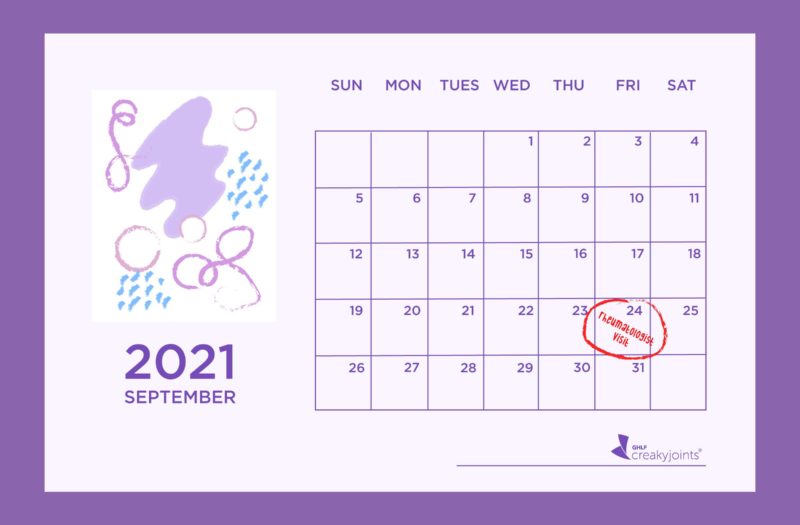When you have pain and swelling in your joints and your family doctor suspects rheumatoid arthritis (RA), they will likely suggest you see a rheumatologist as quickly as possible. Rheumatologists are specialists who focus on diagnosing and treating musculoskeletal disease and systemic autoimmune conditions — also known as rheumatic diseases. This includes rheumatoid arthritis, ankylosing spondylitis, lupus, and others.
Seeing this type of specialist is critical not only because you want answers to why you feel so awful, but also because research shows that there is an ideal window of diagnosing and treating RA that makes a person more likely to achieve remission with less damage to the body from inflammation. The Canadian Rheumatology Association states that the maximum benchmark for the time between referral and first appointment with a rheumatologist should be no more than four weeks. Unfortunately, the reality is very different. There are usually long wait times to see specialists in Canada, and rheumatology has one of the longest. In fact, a 2020 study published in the journal Canadian Family Physician found that the average wait time to access specialty care in Canada is 78 days (a little over two months). This can vary considerably depending on your province or area in which you live (for instance, urban versus rural) — it’s possible to wait months or even up to a year. And while you wait, your rheumatoid arthritis may be progressing at its own speed and stopping you from living your life.
I was diagnosed with rheumatoid arthritis decades ago, during my childhood growing up in Denmark, so I never directly experienced this lag in Canada to see a specialist to get an arthritis diagnosis. But I have had to wait longer than I’d like for appointments to manage my RA and other conditions. I’ve learned a lot from my work as a patient advocate in Canada about what you can to do to better manage your symptoms while you wait to see a rheumatologist and even some tricks for how to possibly move up your appointment and get seen sooner.
How to Manage Rheumatoid Arthritis Symptoms While Waiting for Your First Appointment
Some classic early symptoms of rheumatoid arthritis include swollen and painful joints, as well as a fatigue and malaise, which is a general feeling of unwellness that’s similar to how you feel when you have the flu. Your family doctor will be the most important ally in guiding you through early pain treatment, and possibly prescribing medication to help with symptom control. But addressing your symptoms doesn’t stop there. There are also some lifestyle changes that can help you temporarily manage RA symptoms until you’re able to see a rheumatologist, including:
- Exercise: Although your instinct may be to keep still when you’re in pain, research has found that staying active is very important to keep your joints mobile, as well as maintain muscle tone, which takes some of the strain off the joints. Your family doctor may be able to refer you to a physiotherapist who can help with pain management and safe ways to move your body.
- Ice and heat: Experiment with ice packs and heating pads to see what works best to reduce your pain. You may even want to try a hot shower or bath, which many people find makes moving a little easier.
- Consider topical treatments: Over-the-counter topical pain relievers such as Voltaren gel, Tiger Balm, and Rub A535 can also be useful.
- Adjust your diet: Some people may respond to changes in diet. Studies have shown that the Mediterranean, plant-based, and anti-inflammatory diets may help reduce inflammation which, in turn, may help improve some RA symptoms.
The core principle of managing symptoms of pain and fatigue is to listen to your body and respect its needs. This includes identifying foods and activities that trigger your symptoms, learning to pace yourself, and getting more sleep and perhaps even a nap if you can, perhaps even taking naps for extra energy when you can.
How to (Possibly) Shorten Your Wait Time to See a Rheumatologist
The Canadian health care system mostly works on a first-come, first-served basis, with some degree of wiggle room for emergencies. But when you’re dealing with a specialty that has a shortage of physicians, such as rheumatology, that ability to adjust is quite limited. There are, however, a few ways you may be able to shorten the wait time to see a rheumatologist.
- Get on a wait list: As soon as you have your appointment information, call the rheumatologist’s office to see if they have a cancellation list and ask to add your name to it. If another patient cancels their appointment, the rheumatologist’s front office staff will call patients on the list to fill the time in the schedule. Check with the office every three to four weeks, but remember to be polite and friendly with the staff. Not only do they deserve to be treated well, but having a good relationship with the front office staff can at times be an important factor in seeing the doctor sooner.
- Get multiple referrals: Some family doctors will refer patients to multiple rheumatologists at a time as a lottery approach to getting an appointment. Unfortunately, this clogs the system somewhat, but until there are more rheumatologists, it may be necessary. If your doctor isn’t able to do a multi-pronged referral, they may be able to call the specialist’s office to plead your case.
- Go to the emergency department: If your family doctor is out of treatment options and your symptoms are so bad that you have trouble being able to do basic activities, you do have the option of going to your local emergency department. In extreme cases, they may be able to get you to see the rheumatologist on call or get you a faster referral. Please do keep this option for only worst-case scenarios to make sure people with life-threatening emergencies can be treated.
How to Deal with the Stress of Waiting to See a Rheumatologist
Having your body hijacked by illness and then waiting for answers can be emotionally difficult. Acknowledging the stress of the situation is the first step to dealing with it.
Mindfulness and meditation may already be part of your general stress management, but they can also be very effective for dealing with the stress of illness. The audio version of the short book Mindfulness for Beginners by Jon Kabat-Zinn is a great place to start.
Many find it comforting to lean on family and friends, but they may not fully understand how you’re feeling. If you’re longing to talk to other people who can relate to the RA experience, there are a number of online RA community groups, including CreakyJoints. These groups can be a safe place to ask questions and get support from people with the lived experience to fully understand. To find people with RA online, go to your favourite social media platform and do a search for “rheumatoid arthritis” or check for hashtags, such as #RheumatoidArthritis and #Rheum.
Waiting to see a rheumatologist is frustrating and stressful. Although there are aspects of this wait period that are out of your control, you still have the ability to manage your symptoms and workarounds that may speed up the process, at least by a little. Focusing on what you’re able to control can be an important part of managing your stress, as is support from your loved ones and others in the same situation. Remember that you don’t have to do this alone.
Stay in Touch with CreakyJoints Canada
Part of the nonprofit Global Healthy Living Foundation, CreakyJoints is a digital community for millions of arthritis patients and caregivers worldwide who seek education, support, advocacy, and patient-centered research. All of our programming and services are always provided free of charge. As we grow CreakyJoints Canada we want to hear from you. Please join our email list to stay connected, learn about new content and initiatives, and send us suggestions and ideas.
Liddy C, et al. How long are Canadians waiting to access specialty care? Canadian Family Physician. June 2020. https://pubmed.ncbi.nlm.nih.gov/32532727/.
Wait-time benchmarks for rheumatology. Canadian Rheumatology Association. https://www.waittimealliance.ca//wp-content/uploads/2014/05/Wait-Time-Benchmarks-for-Rheumatology-FINAL.pdf.






